We would like to follow God’s request to worship Him in Spirit and in truth. But in order to understand when to celebrate His Sabbaths and Feasts, we need to have an understanding of the Biblical Calendar. If we allow Scripture alone to lead us, we can learn the Bible truth about God’s calendar.
Click here to download a PDF of this document: The Biblical Calendar
The Bible will show:
-
- God established a Biblical calendar and He uses this calendar to identify His holy days for us to meet with Him.
- On the fourth day of Creation He placed signs in the sky to mark this calendar.
- The Biblical year revolves around the harvest season.
- The year begins with the month when there are ripening heads of barley in late Spring and ends in Fall when the harvest is fully gathered in.
- The sign in the heavens that marks the beginning of the year is the moon, not the Vernal Equinox of the sun.
- The moon also marks the beginning of each month.
- The first visible crescent of the moon after sunset marks the start of the first day of the month.
- Christians and Messianic Believers should observe the harvest and the moon in their unique locations instead of relying on observations in Jerusalem.
We can begin with this verse in Genesis:
“And God said, Let there be lights in the firmament of the heaven to divide the day from the night; and let them be for signs,H226 and for seasons,H4150 and for days, and years.” (Genesis 1:14)
This verse tells us specific facts about the Biblical Calendar.
- God established His calendar on the 4th day of Creation.
- The word “seasons” is the Hebrew word H4150 moed which are God’s appointed meeting times. From the 4th day of Creation, God intended to use His calendar to identify His appointments, which include the weekly Sabbath and His Feasts (Leviticus 23).[1]
- The “lights in the firmament of the heaven” are signs (H226 oth) and will be used to mark this calendar.
- He placed this calendar in the sky for everyone to see, so no one needs to use the internet or follow someone else to determine the Biblical Calendar.
The Harvest
The next thing we learn about this calendar is that God has a preference for the starting point of the year. God told Moses,
“This month shall be your beginning of months; it shall be the first month of the year to you.” (Exodus 12:2)
In the same conversation, God mentions the name of this first month of the year.
“On this day you are going out, in the month Abib.H24” (Exodus 13:4)
From this passage in Exodus 12-13, we can learn that the first month of the year is the same month in which the ancient Hebrews made their great Exodus from Egypt. We also learn that God named this month “Abib.” When we discover the meaning of this word “Abib” we will find that this name alone ties the month to the agricultural growing season.
Looking at this word Abib in a couple of Hebrew dictionaries might give us deeper insight into the meaning of the text.
-
- Abib, Strong’s number H24 = ear, tender, young, green ears of grain.
- Strong’s Definition: pronounced aw-beeb’. “From an unused root (meaning to be tender); green, that is a young ear of grain; hence the name of the month Abib or Nisan: – Abib, ear, green ears of corn.”
- Brown-Driver-Briggs Hebrew Definitions: “1) fresh, young barley ears, barley, 2) month of ear-forming, of greening of crop, of growing green Abib, month of exodus and passover (March or April).”
The first month of the year is named after the condition of the grain when it is tender, green and going to seed.
Season
If we want to know what season of the year this first month falls in, we can find the answer in Scripture by examining the condition of the crops during the time the seventh plague fell on Egypt.
God said to Pharaoh,
“Behold, tomorrow about this time I will cause very heavy hail to rain down, such as has not been in Egypt since its founding until now. Therefore send now and gather your livestock and all that you have in the field, for the hail shall come down on every man and every animal which is found in the field and is not brought home; and they shall die. . . .
“Then the Lord said to Moses, ‘Stretch out your hand toward heaven, that there may be hail in all the land of Egypt—on man, on beast, and on every herb of the field, throughout the land of Egypt.’
“And Moses stretched out his rod toward heaven; and the Lord sent thunder and hail, and fire darted to the ground. And the Lord rained hail on the land of Egypt.
“So there was hail, and fire mingled with the hail, so very heavy that there was none like it in all the land of Egypt since it became a nation. And the hail struck throughout the whole land of Egypt, all that was in the field, both man and beast; and the hail struck every herb of the field and broke every tree of the field.” (Exodus 9:18-25)
This plague of hail fell in the same month that Jehovah brought the Children of Israel out of Egypt. This was the month of the Exodus and the Passover. This was the month named Abib.
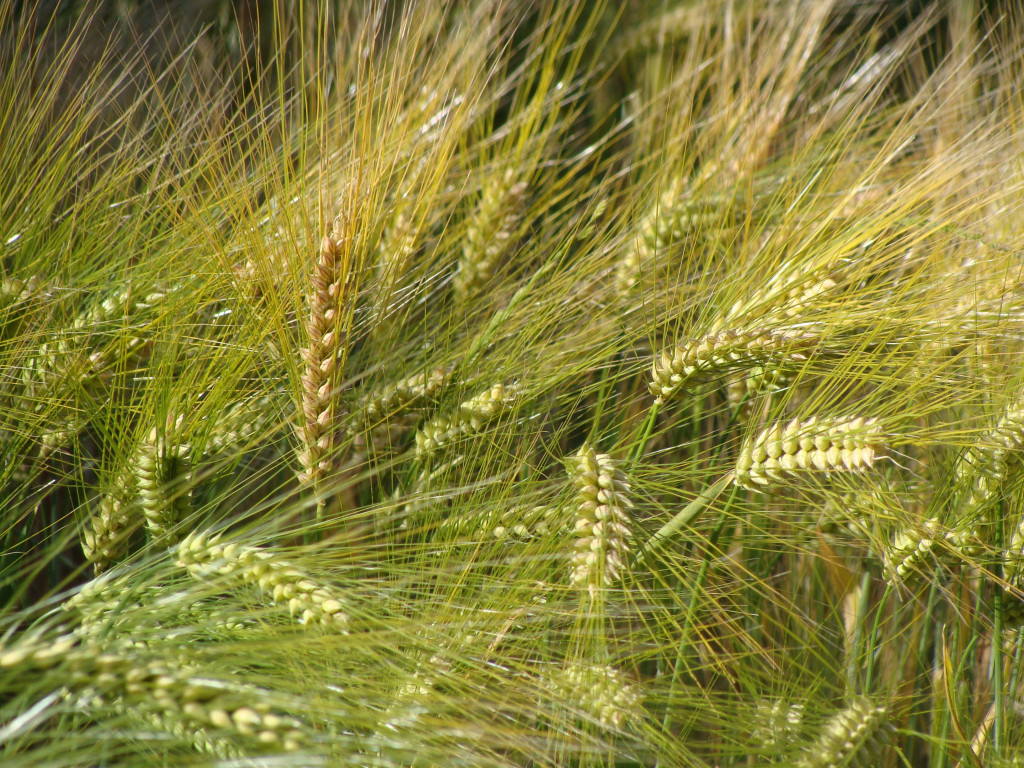 In Exodus 9:31-32 we see four different crops mentioned. Of these, only the barley was in the state of abib. The barley had gone to seed, the flax was flowering, and the wheat and spelt were either not yet sprouted out of the ground or were tender grass that was able to bounce back after the hail. The barley itself is not important except that it helps place the timing of this particular month.
In Exodus 9:31-32 we see four different crops mentioned. Of these, only the barley was in the state of abib. The barley had gone to seed, the flax was flowering, and the wheat and spelt were either not yet sprouted out of the ground or were tender grass that was able to bounce back after the hail. The barley itself is not important except that it helps place the timing of this particular month.
“Now the flax and the barley were struck, for the barley was in the headH24 and the flax was in bud. But the wheat and the spelt were not struck, for they are late crops.” (Exodus 9:31-32 NKJV)
This verse tells us “the barley was in the head.” If you understand the growing cycle, you will recognize that the barley had developed a seed head. The King James Version says,
“The barley was in the ear.H24 ”
In the original Hebrew language, this word “in the head” or “in the ear” is the same word H24 abib. “The barley was abib,” and the month was called Abib, showing that this month corresponded to the particular time in which the barley was in seed.
Firstfruits
In conjunction with His decree to keep this as the first month, God gave further instructions that in this same month His people were to keep the Feast of Unleavened Bread. This Feast included a wave sheaf offering of firstfruits somewhere between the 15th and 21st days of this month.
“Speak to the children of Israel, and say to them: ‘When you come into the land which I give to you, and reap its harvest, then you shall bring a sheaf of the firstfruits of your harvest to the priest. He shall wave the sheaf before the Lord, to be accepted on your behalf; on the day after the Sabbath the priest shall wave it.’” (Leviticus 23:10-11)
God then stated that no part of the new crop could be eaten until this offering had been presented.
“You shall eat neither bread nor parched grain nor fresh grain until the same day that you have brought an offering to your God; it shall be a statute forever throughout your generations in all your dwellings.” (Leviticus 23:14)
Both of these passages in Leviticus 23 also tie the first month of the year to the harvest season through the concept of the firstfruit offering.
When we look to Scripture to learn more about this “firstfruits offering,” we will find that it was made with a sheaf of grain which was in the state of abib or in the stage when there were fully dried kernels ready for threshing. This is explained in Leviticus 2, but we must refer to the original Hebrew in order to see the full explanation of the condition of the firstfruit offering.
“If you offer a grain offering of your firstfruits to the Lord, you shall offer for the grain offering of your firstfruits green heads of grain [H24 abib] roasted on the fire, grain beaten from full heads.” (Leviticus 2:14 NKJV)
Again, from a different Bible version:
“And if thou offer a meat offering of thy firstfruits unto the Lord, thou shalt offer for the meat offering of thy firstfruits green ears of cornH24 dried by the fire, even corn beatenH1643 out of full ears.H3759: ” (Leviticus 2:14 KJV)
From the Hebrew, we can discover the deeper meaning of this verse.
-
- green ears of corn, H24 abib = grain in the stage called “abib.”
- corn beaten, H1653 geres = kernels. There is actually no verb here that refers to being “beaten,” but geres is actually referring to grain that is dried and ready to be beaten out.
- out of full ears, H3759 karmel = a planted field, the fruitful field. This tells us the sheaf of the firstfruits has been newly pulled from the fruitful field. But there is more to discover behind this phrase.
A more literal translation would read: “You shall offer for your firstfruits, green heads of grain roasted on the fire or ripened kernels of grain taken directly out of the fruitful field.”
This description shows two different stages of the ripening of the grain: 1) When it is in the stage of abib, and 2) when it is fully dried and ready to be threshed. A firstfruits offering of any kind can be offered to the Lord in either of these stages.
This text also tells us that this firstfruits sheaf was freshly taken out of the fruitful field when it was offered. A traveler would cut this sheaf and then immediately carry it the several days walk to Jerusalem for the Feast. This could not be grain that was left over from last year.
Barley in Abib
The barley crop, as shown by its stage of development during the Egyptian plagues, was the first crop of the year. From Scripture, we also know it was the only crop that was in the state of abib during the month that the Lord called “abib.” From this we also know that the wave sheaf offered during the Feast of Unleavened Bread is going to be the firstfruits of the barley crop.
But the description of the firstfruit offering we found in Leviticus 2 leaves the start of the year fairly open to interpretation unless we can understand the condition of the crop when it is called “abib.” Is that when you see the very first green heads of grain forming on the barley? Is it, as some are claiming, when there is starch within the kernel? Or is it in the next month when this grain is getting closer to the time it will be harvested? What is the Bible’s definition of “abib?” Let’s allow the Bible to answer this question.
Throughout the growing season, the people could offer the firstfruits of each and every crop, including the firstfruits of the wheat harvest which comes at the Feast of Pentecost. In this way, the development of the wheat harvest could also help us place the first month of the year because it ripens 50 days after the Feast of Unleavened Bread.
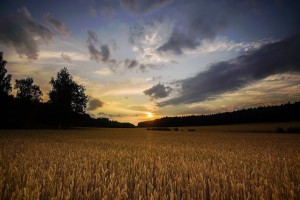
In Deuteronomy, we are shown this relationship between the barley and wheat harvests and we are also given the answer to the question of “Does the year start with the first appearance of seed heads on the barley, or later when it is more developed?” With the instructions for counting 50 days until the Feast of Pentecost, we find the answer we are looking for.
“You shall count seven weeks for yourself; begin to count the seven weeks from the time you begin to put the sickle to the grain.” (Deuteronomy 16:9)
The same day that you begin counting to 50 for the Feast of Pentecost, is the same day as the wave sheaf offering during the Feast of Unleavened Bread. This verse clarifies that the day of the wave sheaf offering is not so early in the season that you have the very first visible green seed heads. It must be at the time when you are immediately ready to begin the harvest by putting “the sickle to the grain.” This is how the Bible gives us the definition of the stage that is called “abib.” The Bible says the first month of the year is when the barley is in the stage of abib. And “abib” is defined as when you are ready to harvest the grain.
Year’s End
The proper timing for this first month of the year can only be placed if consideration is also given to the end of the year which comes in the 7th month. Additional evidence comes with the injunction to keep the Feast of Ingathering at the end of the year.
“And you shall observe the Feast of Weeks, of the firstfruits of wheat harvest [Pentecost], and the Feast of Ingathering [Tabernacles or Sukkot] at the year’s end.” (Exodus 34:22)
This text further emphasizes that the yearly cycle and the Feasts revolve around the harvest season. It also helps to develop the timeline of the new year. By the end of the seventh month, the harvest needed to be complete, the grain sown for the next year and the food preserved for the winter months. This was truly a Thanksgiving festival to be held after the harvest was complete.
For further evidence, Scripture gives us this text about this Feast of Ingathering:
“. . . and the Feast of Ingathering, which is in the end of the year, when thou hast gathered inH622(H853) thy labors out of the field.” (Exodus 23:16)
This phrase “gathered in” is accompanied by a second Strong’s word, H853 eyth which gives it the extra emphasis of completion, surety or finality. Then Deuteronomy 16:13 completes the explanation of the timing of this feast in the 7th month.
“Thou shalt observe the Feast of Tabernacles seven days, after that thou hast gatheredH622 in thy cornH4480, H1637 and thy wine.H4480, H3342” (Deuteronomy 16:13 KJV)
Again, looking into the Hebrew words in this text will give us a deeper meaning. Notice the Strong’s word H4480 minnee is included with both “the corn” and “the wine.”
-
- Gathered in, H622 asaph = gathered, take away or withdraw.
- H4480 minnee = from, out of or after that.
- Corn, H1637 goren = a threshing floor.
- Wine, H3342 yeqeb = the wine vat, coming from an unused root meaning “to evacuate.”
The literal translation would read: “You shall observe the Feast of Tabernacles after you have completely gathered in your harvest and withdrawn from the wine vat and withdrawn from the threshing floor.”
 The Hebrew words in this verse give the understanding that you have not just harvested your grain and wine, but that you have also processed these foods. The work of harvesting and also processing the harvest are completely finished at the time you keep the Feast of Ingathering in the end of the seventh month.
The Hebrew words in this verse give the understanding that you have not just harvested your grain and wine, but that you have also processed these foods. The work of harvesting and also processing the harvest are completely finished at the time you keep the Feast of Ingathering in the end of the seventh month.
The first month of the new year comes when the earliest harvest is ripe. The year continues into the 7th month when the work of the harvest will be complete. You cannot start the new year too early or else, by the 7th month, you will not have completed the harvest. When traveling to Jerusalem to keep the Feast of Tabernacles, the farmers would not have left their fields in the middle of the harvest, nor would they have left their wives and children home alone to finish the processing.
Additional evidence that the Biblical Calendar is linked to the harvest season comes from the specific harvest analogies that are used throughout the plan of salvation and referenced in the lessons of the Feasts. (For example, Amos 8; Matthew 13; Revelation 14.)
Signs in the Heavens
There is ample Scriptural evidence to show that the harvest determines which month of the year is the first month. But we also have to look to Scripture in order to identify exactly which day is the first day of this month. This is important because the exact day of many Feasts are counted from this first day. In the first month, the 10th, 14th, and 15th-21st days all identify events. And then 50 days after the firstfruits offering comes the day of Pentecost. All of these days are dependent on finding the correct first day of the year. And Scripture will help us find the correct date.
We saw that when God established His calendar on the 4th day of Creation, He specifically pointed out that the lights in the heavens would mark His moed—His set appointed meetings.
“And God said, Let there be lights in the firmament of the heaven to divide the day from the night; and let them be for signs,H226 and for seasons [moed],H4150 and for days,H3117 and years.H8141” (Genesis 1:14)
-
- Signs, H226 oth = signal, flag, beacon, sign, marker.
- Seasons, H4150 moed = an appointment, a set time, a set appointed meeting, the act of congregating, an assembly designated for a specific purpose, a Feast.
- Days, H3117 yom = day
- Years, H8141 shaneh = year (as a revolution of time.)
 This text tells us that the lights in the heavens would be signs (H226 oth) that mark God’s meeting times and identify the days and years. But in Genesis, God does not tell us which of these lights will identify the month or the new year. We need to explore other places in Scripture to get this information.
This text tells us that the lights in the heavens would be signs (H226 oth) that mark God’s meeting times and identify the days and years. But in Genesis, God does not tell us which of these lights will identify the month or the new year. We need to explore other places in Scripture to get this information.
Today we consider the “year” to be a solar event that is defined by the cycle of the Sun. So we would assume that the Sun is the light in the heavens that marks the year. And today’s astronomers consider the Sun’s position at the time of the Vernal Equinox to be the zero point in which to start the year. So it is surprising that God does not use the sun to mark the start and end of the year.
We have just learned that the Bible uses the harvest cycle to determine the revolution of the year. With the harvest as the foundation of the Biblical year, God chooses a different and unexpected marker.
Looking again at the text in Exodus 12, we can see that it tells us nothing about the condition of the sun, moon or stars at the time when God said this is the first month of the year. But we are given a clue that relates to the heavenly lights. God said,
“This monthH2320 shall be your beginning of months;H2320 it shall be the first monthH2320 of the year to you.” (Exodus 12:2)
God defines the year by identifying its first month. His emphasis is not on the year, but on the month. The Bible verifies this in another place where it tells us God uses the moon as the sign that marks His Feasts and His appointed times:
“He appointed the moon for seasonsH4150 [moed = set appointed meetings]. . . .” (Psalm 104:19)
These verses tell us that we are going to look at the moon to find the first day of the new year.
New Year’s Day in the Bible
 The moon is an obvious heavenly light to mark the cycle of the month because the moon’s cycle is repeated each month. The words “moon” and “month” are used interchangeably in many languages including ancient Hebrew where we find that they are the very same word. The Hebrew word for “month” tells which phase of the moon starts the new month.
The moon is an obvious heavenly light to mark the cycle of the month because the moon’s cycle is repeated each month. The words “moon” and “month” are used interchangeably in many languages including ancient Hebrew where we find that they are the very same word. The Hebrew word for “month” tells which phase of the moon starts the new month.
Unlike the pagans, who placed great emphasis on the full moon, or the Rabbis who use the dark of the moon when it is aligned with the sun, (called “conjunction” or the “astronomical new moon”), Scripture specifically points to the actual observance of or the sighting of the new moon in the sky.
The word used 256 times in the King James Old Testament is H2320 chodesh. It means “month.” But this very same word also means “new moon.” This Hebrew word helps us know the exact phase of the moon that defines the month. We can see this in Deuteronomy 16:1.
“ObserveH8104(H853) the monthH2320 of Abib,H24 and keep the Passover to the Lord your God, for in the month of Abib the Lord your God brought you out of Egypt by night.
“Therefore you shall sacrifice the Passover to the Lord your God, from the flock and the herd, in the place where the Lord chooses to put His name.” (Deuteronomy 16:1-2 NKJV)
Again we turn to the Hebrew words to see the deeper meanings in this passage.
-
- “Observe” is H8104 shamar plus H853 eyth, which means: to keep, protect, observe visually, attend to, wait for or watch for.
- As we saw earlier, the added H853 eyth makes it a superlative and gives body and added emphasis to its importance and longevity. So this means, surely observe or specifically observe.
- “Month” is H2320 chodesh = month or new moon
- “Abib” is H24 abib = green heads of grain
 Every time you find the phrase “new moon” in Old Testament Scripture it is from the Hebrew word chodesh. Chodesh originates from the primitive root word, H2318 chadash which according to Strong’s means:
Every time you find the phrase “new moon” in Old Testament Scripture it is from the Hebrew word chodesh. Chodesh originates from the primitive root word, H2318 chadash which according to Strong’s means:
“to be new; causatively to rebuild: – renew, repair.”
This is how the word “new moon” got its meaning. The specific phase of the moon used to locate the start of the month is when it is “new.” This is when it appears to be renewing or rebuilding in the sky.
The text in Deuteronomy specifically says observe the new moon. This instructs us to actually see the first visible crescent of the new moon in the sky. Since the words “month” and “new moon” are interchangeable, how did the Bible translators choose to use “month” instead of “new moon?”
The Hebrew tells us this text literally reads,
“Look for the new moon at the time when there is ripening grain and keep this month.” Deuteronomy 16:1
While refreshing the Passover instructions in this text, God also is giving very precise instructions as to when to begin the new year.
-
- The month that the Passover falls in is the first month of the year.
- This month is called Abib because it corresponds to the month when there are ripening heads of grain. The barley is the crop that is in the state of abib during the month of Abib.
- We are to visually see the new moon at the beginning of this month.
- We are to surely look for this month.
We are to observe by both visually seeing the new moon and by attending to the importance of this month. We are to surely observe by waiting for it, watching for it.
This month is called Abib because it is the time when there are heads of grain ripening in the field. The month of Abib is not when the first signs of seed heads appear on the grain, but when the grain is almost ready to be harvested.
God very clearly spells out His calendar. And He gives very clear direction that He wants us to follow this specific calendar for arriving at the dates for His set appointed meetings. He says,
“Observe the new moon when there are ripe heads of grain.”
“This month shall be your beginning of months; it shall be the first month of the year to you.” (Deuteronomy 16:11 and Exodus 12:2)
Once you have seen the new crescent of the moon during the first month of the harvest, you can then find your way to the rest of the Feasts simply by counting.
-
- The evening in which you see the moon, and the day following it, is the first day of the year.
- The Passover is prepared on the 14th day of that month and eaten that night before sundown.
- The Feast of Unleavened Bread is from the 15th day until the 21st day of this first month.
- The day after the weekly Sabbath during the Feast of Unleavened Bread is the day of the Wave Sheaf. From this date you count 50 days to Pentecost which also falls on the day after the 7th-day Sabbath. Pentecost always falls on the 1st day of the week (Sunday) as shown by the two different ways to count to it in Leviticus 23:15-16.
- Then you simply count six more months until the 7th month. Again you look for the new moon so you can find the first day of the 7th month. That day is the Feast of Trumpets.
- On the 10th day of this month is the Day of Atonement.
- From the 15th to the 20th days is the Feast of Tabernacles.
- Then on the 21st day is the Last Great Day.
The Bible Calendar
Relying on Scripture alone, we have the complete definition of the Biblical Calendar. God wants us to follow His calendar that He established on the Fourth Day of Creation. Finding the correct timing for His Sabbaths, Feasts and moed depends on understanding this calendar.
-
- The year begins in late Spring, not at the first signs of Spring, but when the first crop of the season is ready for harvest. In North America, this corresponds to the end of April and the beginning of May. (Read more about the New Year in Late April, Early May.)
- The first day of the month can be determined by physically observing the first crescent of the New Moon in the western sky. Repeat this observation in the 7th month to determine the exact days for the Fall Feasts.
- The year concludes in the Fall, in the 7th month, when the harvest is fully taken in. This 7th month cannot be both the end of the year and also the beginning of the year, contradicting the Jewish practice of celebrating the New Year in September.
- The light in the heavens that marks both the year and the months is the Moon. The Vernal Equinox of the Sun is not the heavenly sign that marks the new year.
- The Sun is the light in the heavens that marks the day, its setting and rising clearly identifying each day.
- The new day begins at sundown, for God said, “From evening to evening, shall you celebrate your Sabbath.” (Leviticus 23:32)
- A week is composed of seven of these days, ending with the Sabbath. The Sabbath is found by observing the Sun (not the Moon) and counting seven days.
“And on the seventh day God ended His work which He had done, and He rested on the seventh day from all His work which He had done. Then God blessed the seventh day and sanctified it, because in it He rested from all His work which God had created and made.” (Genesis 2:2-3)
“Six days shall work be done, but the seventh day is a Sabbath of solemn rest, a holy convocation. You shall do no work on it; it is the Sabbath of the LORD in all your dwellings.” (Leviticus 23:3)
When God gave His Ten Commandments to Moses and wrote them on the Tables of Stone, He specifically reminded us to follow the Biblical Calendar. He said to keep the Feast of Unleavened Bread “in the appointed time of the month of Abib.” (Exodus 34:18) Only with the knowledge of the true calendar will we be able to identify the times when God desires to meet with us.
Location — “Where I Put My Name”
By looking to the Bible we have outlined the Biblical Calendar. But today, there is a question about location. God had originally told the Hebrews to come to meet with Him on three Feasts at the location that He chose and where He placed His name.
“Three times a year all your males shall appear before the Lord your God in the place which He chooses: at the Feast of Unleavened Bread, at the Feast of Weeks, and at the Feast of Tabernacles; and they shall not appear before the Lord empty-handed.” (Deuteronomy 16:16)
And the location where He placed His name was in Jerusalem.
“And to his son I will give one tribe, that My servant David may always have a lamp before Me in Jerusalem, the city which I have chosen for Myself, to put My name there.” (1 Kings 11:36)
The calendar questions circling the globe are “Should we look for abib barley in Jerusalem?” And “Should we base the new month on the sighting of the new moon in Jerusalem?”
At first it appears that this question could have several possible answers. We could look for the harvest in Egypt since that is where the crops were struck by hail when God gave the instruction to keep this as the first month of the year. Or we could go by the status of the abib in Jerusalem since that was where the Lord chose to place His name. But Christians have a different answer. The Jerusalem temple is no longer the place where God dwells or where He chooses to place His name.
Jesus said, “The hour is coming when you will neither on this mountain, nor in Jerusalem, worship the Father. . . . But the hour is coming, and now is, when the true worshipers will worship the Father in spirit and truth; for the Father is seeking such to worship Him.” (John 4:21, 23)
Jesus said, “For where two or three are gathered together in My name, I am there in the midst of them.” (Matthew. 18:20)
“The Lord will be awesome to them, for He will reduce to nothing all the gods of the earth; People shall worship Him, each one from his place….” (Zephaniah 2:11)
“Then I looked, and behold, a Lamb standing on Mount Zion, and with Him one hundred and forty-four thousand, having His Father’s name written on their foreheads.” (Revelation 14:1)
“What? know ye not that your body is the temple of the Holy Ghost which is in you, which ye have of God, and ye are not your own?” (1 Corinthians 6:19)
God has placed His name in the foreheads of His servants and our bodies are the temple in which He dwells. No longer can you only find God in Jerusalem. God’s Shechinah presence no longer dwells above the mercy seat in the earthly temple in Jerusalem. We no longer need to follow priests and rabbis to maintain our connection with God, “For there is one God and one Mediator between God and men, the man Christ Jesus, who gave His life as a ransom for all.” (1 Timothy 2:5-6)
God has come to each and every one of us in the form of His Holy Spirit. When we are gathered together to worship Him in the name of His Messiah, He will gather with us in our midst. (More information about the current location of God’s Temple is in Isaiah 66:1 and Revelation 21:22.)
The Sabbath day begins at sundown on the sixth day of the week. This moment does not happen at the same instant throughout the world. God is able to accept a flow of worship as the sun sets and the Sabbath day begins. In the same way, the “set appointed meetings” of God—or His Biblical Holy Days—do not need to begin at the exact same instant throughout the globe.
The Feast Days revolve around the theme of the harvest. And following the growing season in your locale will help you to understand the lessons embodied by the Feasts. Whether you are in the Northern or Southern Hemispheres, you can look for barley growing in your area or the grasses in your backyard, but you should at least try to center the year around the growing season in your location.
If you live in a city or climate that does not lend itself to a harvest, you unfortunately have lost some of the impact of the harvest lessons. But do not fear, no matter where you are, you will at least be able to look out for the crescent moon in the late April to mark the start of the year.
The lights in the heavens mark God’s calendar so every person can see them. Just as you might tack your calendar to your wall, God has pinned the Moon in the sky for all to see. Each month you can watch for the first crescent of the new moon in the western sky after sundown and know that this night marks the start of a new month.
The important point is to be reliant on God and to place Bible truth foremost in our lives. With this as our starting point, the Lord will be able to lead us into more and greater truths. We need to keep our eyes fixed on Jesus, just like He told Peter, “You, follow Me.” Wherever you are, you can gather together to rejoice and worship the Father in Spirit and in truth. The Father is seeking such to worship Him.
May God bless you as you rejoice with Him on His new moons, Sabbaths and Moed!
[1] Strong’s Hebrew numbers and definitions are taken from Strong’s Exhaustive Concordance of the Bible, James Strong, World Bible Publishers, 1890.

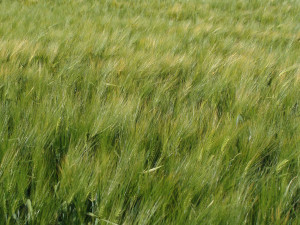
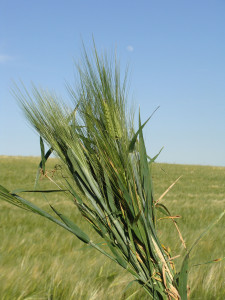
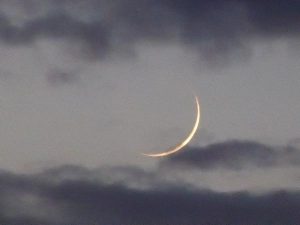
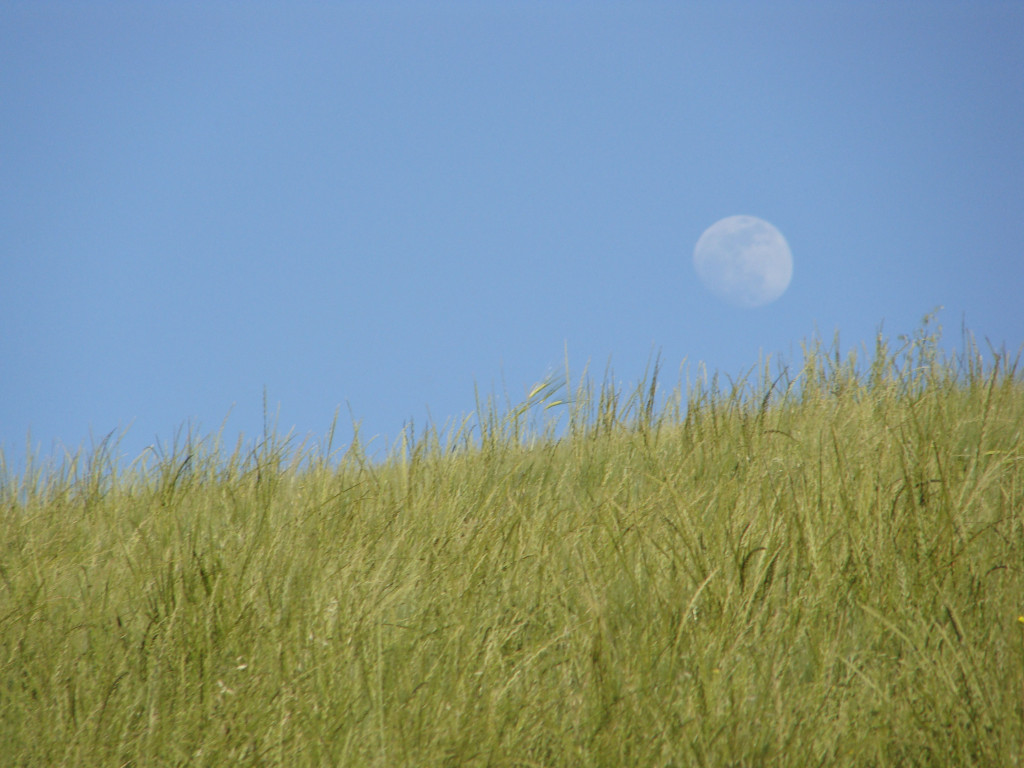
God created the DAY and NIGHT first. DAY = 12 separate parts (we call them hours). NiGHT = 12 separate times broken into 3 watches. Midnight and Midday are both descriptions of specific times that bisect 12 parts into 6 parts. Evening only describes when the sun goes down. Morning only describes when the sun goes up. The day and night have part of evening and the morning.
God created during the Day and then stopped.Time started at day/night cycles. Time was ticking. A countdown till the end of our current situation occurred on the 4th day. God put a meeting invite in his calendar. I hope ya’ll make it!
Evening came and then morning. A full day. Morning doesn’t describe or ever mean a full 12 parts of DAY and neither does evening describe a full 12 parts of NIGHT. The Day starts at sun up and ends at the next sun up. Some Mo’ed start at evening till evening like Passover, but not all.
Many accounts in the Bible say tomorrow begins when there is a sunrise, not ever evening. Judges, Isaacs sacrifice, Manna falling…..just read it.
God does describe other peoples way of accounting for time that isn’t his way. Babylonian, Roman, Pharisee. Map put the Crucifixion timeline, Pharisees celebrated Passover AFTER Jesus did. The Pharisees have evening to evening timelines. What did Jesus think of the Pharisees???
Start questioning what you’ve been taught and re-read the Bible.
Hi Ramien. I’ve been around the block already on this issue of the “day” beginning at sunrise, so I’m not going to spend much time on this.
The Bible defines the day cycle in this way. “And the evening and the morning were the first day [yom.]” (Genesis 1:5) And also: “From evening to evening will you recon your Sabbath [shabbat.]” (Leviticus 23:32) Even Daniel gives us a countdown to the end in the same way. “Unto 2300 Evening-Mornings, then shall the sanctuary be cleansed.” (Daniel 8:14)
So, the conclusion to draw from a simple thus-saith-the-Lord, is that HE defines the day as starting and ending at evening. He marks the boundaries of His Sabbath as evening to evening.
My advice is to go back to the simple truth of the Bible and be more wary of whom you are listening to. This is clearly not your own unique theory. Your whole hypothesis about 12 hourly increments and midnight and midday markers is where in the Bible? I advise you to spend your time seeking righteousness. This theory that the day begins at sun up is just another ploy of Satan to cast doubt on the integrity of the Word of God and it serves no purpose in leading anyone to salvation.
But God is powerful enough to keep His word intact through all these years so that even a simpleton can find Salvation.
Seek truth. Ask God if your arguments will hold up in His face. God Bless.